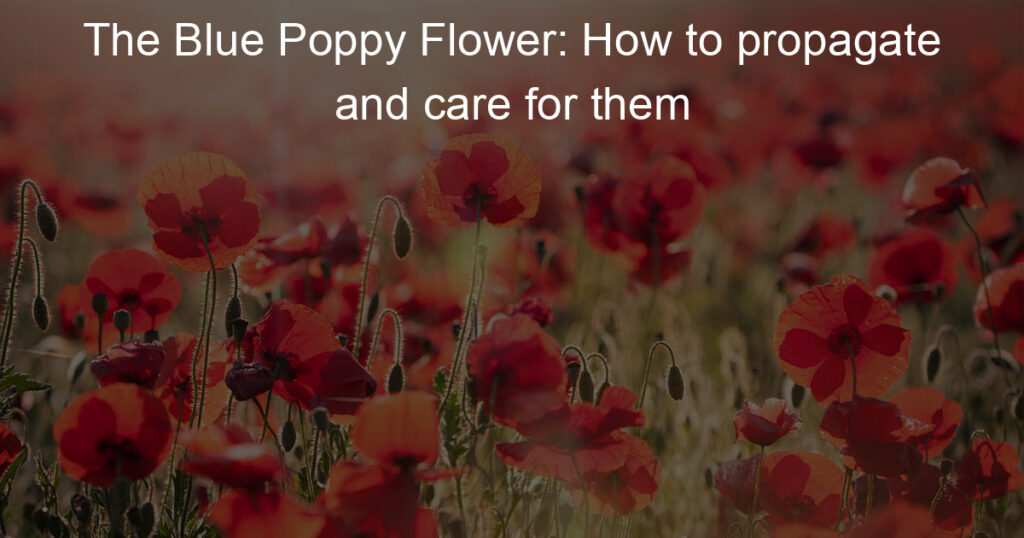Are you looking to add some mesmerizing color to your garden, front yard, or backyard? Look no further than the captivating blue poppy flower! Not only are these flowers incredibly gorgeous with their desired coloring and texture, but they also make for stunning additions to bouquets and centerpieces.
Poppies don’t just come in blue either – different colors of poppies include pinks, whites, yellows, and whites. Keep reading this post if you want to learn more about propagating and caring for poppies so that you can have a vibrant oasis right in your backyard!
How do you grow blue poppies?
Growing blue poppies can be a challenging, yet rewarding task. As cool-season bedding plants, ideal temperatures for these incredibly beautiful flowers range from 40-65 degrees Fahrenheit. Blue poppies thrive in partial shade and moist soil, so gardeners should look for spots that receive 6-8 hours of direct sunlight and are next to water sources or irrigation systems.
Nutrient-rich compost will help the plant build strong stems capable of supporting the showy blooms, and ample drainage is needed so the roots don’t become waterlogged. One key aspect to note is that the soil must be kept moist; during warmer months it may need watering up to twice a day.
Planting blue poppies takes patience, but with a little tender loving care, they will make any garden look like magic!
Can you propagate poppies?
Propagating poppies is pretty simple, and with a little bit of effort and care it can be done fairly easily. The process of propagating poppies is nothing more than taking a small stem from a plant and planting it in the soil to grow an identical plant.
Most people start the propagation process by cutting off 4- to 6-inch stem pieces that have a few leaves on them, then planting the stem piece in some nutrient-rich potting soil. After the poppies are planted, the top layer of soil should be lightly misted, making sure not to drown out the stems or cover them entirely with soil.
Once watered, these cuttings should start producing roots within a couple of weeks, once they do you’ll know your poppy propagation project was successful!
How do you start blue poppy seeds?
Starting blue poppy seeds is a great way to start a flower bed in your garden! Before getting started, you’ll want to make sure you select a spot in your garden that has plenty of direct sunlight throughout the day.
You should also use good-quality potting soil and sow the poppy seeds about ¼-inch deep before covering them with soil. Regularly water your seeds for the best results and watch for germination within 2-4 weeks.
To help keep your soil moist, you can also add mulch around the seedlings when they emerge. Provide nutrients as needed with fertilizer throughout the growing season.
With a little bit of care and patience, your beautiful blue poppies will be blooming in no time!
What is the best soil for the Himalayan blue poppy?
Living in the Himalayas, the Himalayan blue poppy is a unique plant unlike any other. Their soil requirements are just as unique! The blue poppy is known for preferring well-drained, silty, and slightly alkaline soil with pH levels of 6.5 to 7.5.
A good combination of different types of soil stimulates strong root growth and encourages the flowering process to take place more quickly and with more visible results. Compost or aged leaf mold can help improve soil texture and minerals for the blue poppy, adding natural nutrition for better blooms and growth.
The key to providing the best soil for your Himalayan blue poppies lies in understanding what they need so that their environment supports them throughout their life cycle!
Where are blue poppy seeds grown?
Blue poppy seeds may sound like an ingredient found in a fantasy novel, but they’re real. If you’ve been searching for these bright blue seeds, look no further than the foothills of the Himalayas, where they grow naturally – or in Uzbekistan or Kazakhstan.
While these regions are famous primarily for their mountainous terrain and historical landmarks, their soil is also excellent for the cultivation of a wide range of flowers and plants. Of those plants that can take root in this region of Asia, blue poppy seeds are perhaps some of the most unique.
Used as a distinctive topping for bread and bakery goods in many countries around the world, these tiny but vibrant seeds never fail to excite the senses.
Can you propagate poppies?
Poppies are a popular flower, used regularly in floral arrangements to add a bit of color and beauty. Though many people know about planting poppies from purchased seeds, propagating poppies is also an option.
This can often save you some money and require less effort when preparing your garden beds. To successfully propagate poppies, simply find ones growing in the wild or divide clumps of existing plants.
Once they’re in the soil, give poppies the adequate water, sunlight, and soil condition they need and they will thrive without much attention on your part. By propagating your poppies you can help to build up their numbers out in nature as well as enjoy their beauty closer to home!
On the Whole
As you can see, there is much to learn and understand about Blue Poppy Flowers. Not only are they beautiful and exotic, but they can thrive in a variety of climates, and people who invest the time to properly propagate and care for them will be rewarded with an amazing flower that makes a statement like no other.
Whether you choose the Tibetan Blue Poppy or one of its related varieties, you won’t be disappointed with your choice. Just remember, propagation takes patience and perseverance, not to mention the correct methods.
But when done properly, you’ll be on your way to cultivating these incredible flowers! So good luck and enjoy growing the fabulous Blue Poppies!














